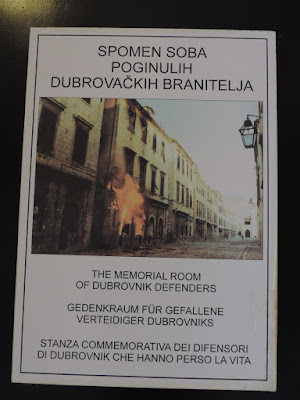After checking out of the hotel, we drove to Mount Srd, the mountain-top point overlooking Dubrovnik. It provided a wonderful view of the city, giving perspective to the city and the surrounding area. We wanted to return to the Walled City, but we had problems finding a parking spot, so returned to the hotel, ordered a taxi to take us downtown. It was more expensive, but the best plan.
 |
| Mt Srd on Right |
 |
| Monument on Mt Srd |
 |
| View from Mt Srd |
We
liked the old walled city of Dubrovnik, but it did not have the character of
the walled Diocletian Palace in Split.
We are glad we spent the extra days in Split.
 |
| Dubrovnik Cathedral |
 |
| City Gate |
It was almost noon before we were on the road to Bosnia-Herzegovina, with a destination of Mostar. We wanted to see the Old Bridge (Stari Most) in Mostar.
The
recent history of this whole area (former Yugoslavia) is interesting yet
confusing. It depends on your origin,
as to how you feel about the whole situation.
Feelings and tensions will be there for several generations, but by then
nationalist feelings could be stirred up!
We
are planning to drive a rural road that cuts across the country-side from Dubrovnik
to Mostar. After you leave the coast,
you climb over one mountain range and then another. These are rocky barren mountains. We did see
several beautiful snow-capped ranges in the distance. There is not enough grass
among the rocks for grazing, even for sheep.
The rocks look like they are growing out of the ground. Anything green was low shrubs, barely
surviving. Yes, deserts are barren, but this was a different kind of
barren. It was an interesting drive. Every once-in-a-while you saw a small village of several homes, but there were no larger villages along this route. As to how these people make a living, we have no idea. We began seeing small slate-roofed Orthodox chapels, each with a cemetery surrounding it. We stopped at several, looking at the dates on the memorial stones. We did find it interesting, that other than the little chapels, there were no churches in the villages.
 |
| Water Wheel |
Farther up the same river we drove through a valley that is prone to flooding. The small villages sat on the edge of the valley. However, they were using the rich soil of the river bottom to grow crops – lots of vineyards and other crops. It appears they had built a network of drainage channels, with raised areas on which they planted grapes, etc. This appeared to be a productive area. Interestingly, this river flowed south to the river delta we saw the other day where all the citrus is grown.
Finally, we arrived in Mostar. We followed the GPS to the Old Bridge. This bridge was reconstructed just like the original old bridge in the mid 1990’s. During the Yugoslavic war of the early 1990’s, all of the bridges across the Neretva River were destroyed because the leader, at the time, wanted the river to be the natural boundary between the Croats (Catholics) on the west side and the Bosnia’s (Muslims) on the east. (This is the man who committed suicide (drinking poison) in the World Court, in The Hague, Holland, in November of 2017, after being convicted and sentenced due to war crimes during the war). Needless to say, he is not very popular in Mostar.
 |
| Ancient Mostar Bridge |
Can
you imagine a city where people used the bridges every day to go back and forth
across the river, and all of a sudden the bridges were destroyed?
We
decided it would be neat to see the bridge lite up at night, so we found a lovely
restaurant in the old town for dinner. After several more photos of the bridge
at night, we were on the road back to Croatia.
It was dark, so we could not see the landscape. We know we were driving in a river valley, so
it would have been nice to view the area, but we made the choice to see the
bridge at night. Here again, it is not
late, as it is dark by 5:00 pm. Before crossing the border, we began driving on the A-1 Tollway. Since we already had dinner, we decided to keep rolling until we were as far north as Split. The Tollway goes through an area of the country that is barren. We had seen this area driving south, so there is no need to see it again in daylight hours. We found a hotel near the A-1 outside of Split.























No comments:
Post a Comment